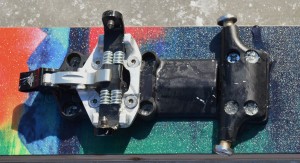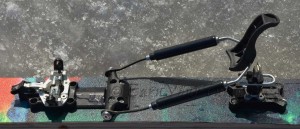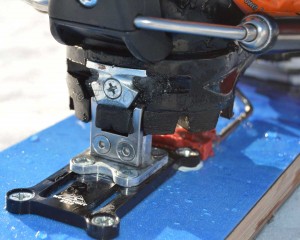Key Features
What distinguishes Moonlight’s tele tech binding from the original TTS by OMG are:
- A roofed spacer to minimize snow build up underfoot
- Cables that are easily removed to reduce touring weight
- Optional, longer spring cartridges to allow knee-to-ski motion
- Two options to improve lateral stability at the heel:
i) by locking it with a minimalist AT low-tech heel, or…
ii) using a heel stabilizer to improve free heel lateral stiffness
Roofed Spacer

Common features of Moonlight telemark tech bindings:
tech toe + roofed spacer + cable connection post = 300g.
Low-Tech Toe Details
The current incarnation of the low-tech toe unit is a common knock off design made originally for skimo racing with a focus on lightweight. Thus, it takes a bit of careful alignment between the boot inserts and pins to latch in. Experienced Dynafiddlers won’t notice anything unusual; inexperienced newbies will have to figure out their own fiddle factor. In addition, it rarely gives a resounding snap as it closes. Thus users are strongly advised to swing the toe to make sure the pins are clamped tight. Bjarte Hollevik, Moonlight’s founder, acknowledges in humid conditions it can pack with snow, preventing the pins from fully seating. An improved toe unit is on the drawing board with clear paths to allow snow to escape and not be trapped under the toe arms (aka jaws).
Cable System
For the Pure Tele Moonlight binding testing was done with an obviously prototype configuration where the climbing wire pulled up from the front. The final version will pull from the heel, much the same as many existing heel posts so it will probably require a ski pole with a hard, bird’s beak sort of grip to be able to quickly, reliably pull the climbing wires up. With any luck, Moonlight will work a deal with 22 Designs for a spring loaded climbing wire.The actual cable is a Voile Hardwire cable unit, with the option to get an extra long spring cartridge for people with big feet that need more travel distance on the springs. This is one of the obvious improvements Moonlight will offer. However, the heel lever latching the cable around the heel is the standard Voile heel lever, made for latching on to a 75mm boot with a heel groove, not on the top of the heel step. For it to yield a reassuring snap when you latch it on, it needs to be tight enough that putting it on takes a little extra effort compared to an OMG heel lever.
The position of the cable tested depended on the exact pair of skis tested. The proposed pivot location of the cable is expected to be approximately 5.5 cm behind the toe pins. Adjust-ability will be limited to where the cable post bracket is mounted.
My only semi-serious complaint was that the heel posts did not allow for simply latching the heel lever behind the climbing post to keep the cable tucked out of the way when climbing, or slinging the skis over your shoulder. It was assumed I would want to take the cables off to save weight for climbing. For a long climb, maybe I would. As a telemarker though I’m used to much worse and I’d rather have the cables ready to snap on my heels at the top of a climb and de-skin with skis attached than have to take my skis off to add the cables, remove the skins, and then, click back in to the binding. How embarrassingly similar to the inconvenient, time consuming procedure AT skiers put up with. 😉
Improved Lateral Control
Where Moonlight ups the ante in the telemark tech realm is with their two heel options. The most obvious, a feature often talked about, is the ability to use a lightweight tech heel, available with the Tele Rando binding. The heel unit is reminiscent of a Spartan tech race heel with a non-adjustable release value of approximately eight. This means the height of the climbing post when climbing is either flat or the equivalent of a low, 5° climbing post, something many free heelers will be underwhelmed by. However, if you want the ability to easily, and quickly, lock the heel, then this climbing limit may be acceptable. Keep in mind that with a flexible sole in a tele boot, you need less post height to maintain good skin grip. For a stiff soled AT boot, 5° isn’t much, but with a flexible tele boot, with good technique, it should be enough.
If you’re in the camp that a 5° climbing post is not enough, or you don’t need to fix your heel ‘cuz free heels are not a problem, Moonlight offers the Pure Tele binding. In this binding the heel unit comes with a higher climbing post (estimated ~10° incline) and a heel stabilizer which is a V-shaped piece of metal that, when properly positioned, hugs the sides of the heel insert of an NTN boot so that there is very little lateral slop at the heel when flat. It doesn’t prevent making a telemark turn while adding extra lateral control to both feet in a parallel turn, or the front foot in a tele turn. As is clear from the photo with the heel stabilizer, the associated climbing post is clearly an option still under development, but it added noticeable lateral control.Conclusion
As mentioned earlier, this is based on a cobbling together of various existing parts for elements like the tech toes or heels, and the cables. The unique items that Moonlight brings to the table were tested in varying degrees of prototype development. The clear conclusion was that, even in prototype form the functionality was there. Any issues that were experienced were due to things like missing screws that weren’t properly tightened and came loose in the field, or were over tightened and couldn’t be easily adjusted. The validity of the performance comes from the fact that over a dozen of us were subjecting both the Tele Pure and Tele Rando bindings to a variety of conditions with different styles and expectations, but no serious complaints.
The only murmurs of disappointment I heard were about the dwindling availability of compatible telemark boot choices.
Moonlight Mountain Gear
Pure Tele
MSRP: $500
Weight/foot: 300 g (toe+heel+cable post) + 650g (cable)
Tele Rando
MSRP: $700
Weight/foot: 350g (toe+heel+cable post) + 650 g (cable)
© 2015




14 comments
Skip to comment form
Thanks for the thorough review. I miss a bit more description about how you rate these bindings on the descent. How do they compare to NTN+AXL etc? I am an early adopter of these bindings. I have two days on them so far. I come from 22 designs axl and T1 boots. The feeling is quite different and I am not very confident yet but I think it will work out 🙂 The things that are most “difficult” to me:
1. The added stiffness on the rear foot requires me to adjust the rear foot more precisely when turning. I guess this is a good thing really.
2. I have size 280 boots and I need to ride more up-right than I am used to because of the short (normal) sized springs. Looking forward to getting the long springs.
I must say that saving weight on the up easily wins over saving time at the top. I am happy that the springs can/must be detached!
As far as the downhill power quotient goes, it’s very similar to TTS, or at least HH#3, some thought more like HH#4. YMMV depending on where you mount the cable posts. I didn’t have enough time to compare to other known bindings in a quick side-by-side comparison which I prefer to do before making such a claim. Nor did I actually measure the position (shame on me). When I have more time and can make a statement on that I will.
Your experience of needing to adjust how/WHEN you weight the rear foot in the tele turn is spot on. I find it is easier, and more powerful, especially with underfoot routed cables, if you initiate the turn by stepping back on to the rear, rather than forward on to the front then shifting to the rear. Start by weighting and angling the rear to start the turn.
Great overview! I had a few questions:
1. Is it possible for one to use a different brand of tech toe, as long as it fits the old Dynafit 4-hole standard? It looks like that might be possible.
2. How does one change the pivot cable location relative to the pin line? Are there multiple positions to mount the tech toe on the roofed spacer? If so, it appears that there may be 2 pivot options?
3. The future extra long spring travel would ostensibly retrofit OMG TTS bindings as well, yes?
I have been using OMG TTS with great results- the only concern being the spring travel hard stop (which I have not yet bottomed out in use). Even at the most forward possible pivot location it is still more active than my rottefella NTN bindings and only allows my knee to 10″ off the ski- something like HH #3.5. It skis more similar to an active cable binding than NTN imho. Overall, the only benefit I can see to switch from OMG to MMG is the removable cable since it appears that the MMG also has a limited spring travel. otherwise the OMG seems lighter, lower stack height, tall climbing bail, better heel lever, adjustable activity, and cheaper.
Answers to some of your Qs are still up in the air – to be defined. F’rinstance, using a different toe, such as a Dynafit TLT or Vertical, or a Plum, or ATK, or G3’s Ion – to which I suspect you can if you are good at making your own modifications to incorporate the snow shedding spacer and the cable post.
As for the position of the cable post, it has not yet been determined if that will be adjustable. If it is, the adjustment will probably only be 1 cm and I don’t know if that means one position change of 1 cm, or two at plus/minus 5 mm.
Re: a longer spring cartridge. Since it’s from Voile, the threads will be compatible with an OMG cable. The longer length may require a different length cable though, depending on boot size and pivot location.
Awesome to see all these new bindings coming into the market. It’s a good time to be making tele turns. If only winter could return to “normal”
Is the longer spring cartridge currently available to purchase?
How “active’ was the cable? I’ve become addicted to 22 designs’ most aggressive setting (shame on me?). This keeps my rear foot low and squarely on the ball of my foot. My voile switchbacks now feel terribly sloppy. thanks
Haven’t been able to do a side-by-side but the basic design is the same as the original TTS so it felt very active, like HH#4 for initiation, but with softer springs, so not overwhelmingly active. Of course, you could adjust the position of the cable pivot when you mount it to suit your personal preference, although it isn’t as easily adjusted, once mounted, as TTS.
I just communicated with Voile so can answer my own question about availability of the longer spring cartridges.Voile is manufacturing the cartridges but they will be sold only by Moonlight. The longer cartridges have not been manufactured or shipped yet. I was instructed to contact Moonlight for more info.
Given how out of date Moonlight’s website is, I somewhat assume Moonlight will make Meidjo appear like customer service superstars (translation – I am giving up hope of getting on a TTS setup that I can actually ski anytime in the near or distant future).
Thanks for the article – great read. How do these compare to rottefella NTN? Also are these bindings releasable?
Releasability is possible but not probable, at least in downhill mode. As for a comparison with NTN, it is more active than Freeride or Freedom in turn mode. Not exactly comparable since it attaches at the heel, NTN attaches at the 2nd heel, so the sensation is not exactly the same. It is way more efficient for touring.
Thanks for the review – how does this binding compared to Meidjo?
You mean in terms of tele-resistance when cranking turns? Touring is identical, although Moonlight is simpler for that. When turning the Moonlight is more active, Meidjo is more like a Switchback, only it engages immediately, not slowly like the SW.
Thanks for a thorough review. Looking forward to the Telemark binding selection guide 2015! Ref. Weight/foot: 300 g (toe+heel+cable post) + 650g (cable)
Do the cable actually weigh 650 per foot?